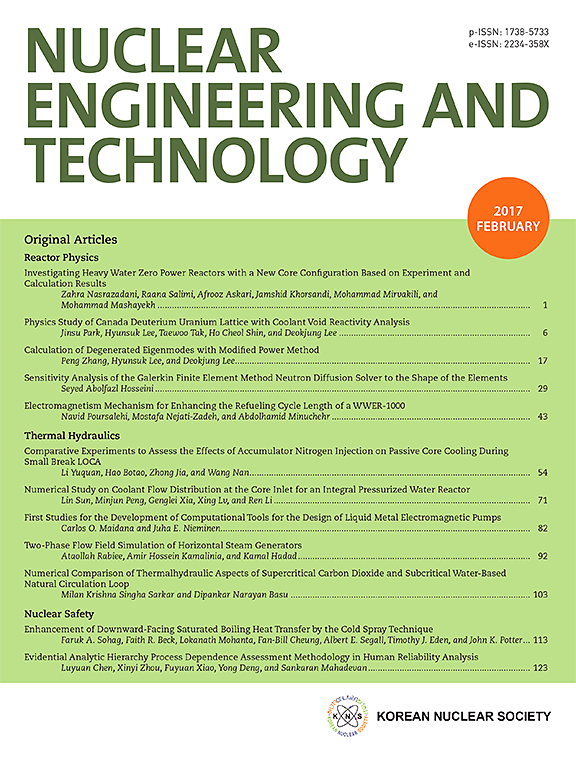Characterization of evolution of reactive transport parameters during leaching process of sandstone uranium ore by combining porosity and lacunarity
IF 2.6
3区 工程技术
Q1 NUCLEAR SCIENCE & TECHNOLOGY
引用次数: 0
Abstract
During the in-situ leaching process of sandstone uranium ore deposits, the dynamic evolution of reactive transport parameters, including permeability, tortuosity, and specific surface area (SSA), plays a crucial role in solution flow and solute transport. Characterizing the evolution of these parameters is essential for understanding the leaching process. However, the heterogeneous pore structure of sandstone renders porosity alone insufficient to capture changes in these parameters. This study combines porosity and lacunarity to comprehensively characterize these parameters. For this purpose, leaching experiments were conducted on sandstone uranium ore samples, and CT imaging was performed at different leaching time points. The evolution of reactive transport parameters was analyzed by studying cubic subsamples from the images. The results indicate that both porosity and lacunarity are significant factors influencing the reactive transport parameters. However, neither parameter alone adequately characterizes their evolution. In contrast, combining them accurately characterizes the evolution of reactive transport parameters. Porosity reflects pore quantity, while lacunarity represents pore heterogeneity. Combining these measures facilitates a comprehensive understanding of the evolution of reactive transport parameters and the influence of pore microstructure on macroscopic reactive transport parameters. This research provides valuable insights for optimizing the leaching process in sandstone uranium ore deposits.结合孔隙度和裂隙度分析砂岩型铀矿浸出过程中反应输运参数的演变特征
在砂岩铀矿床的原地沥滤过程中,包括渗透率、迂回度和比表面积(SSA)在内的反应性迁移参数的动态演变在溶液流动和溶质迁移中起着至关重要的作用。确定这些参数的演变特征对于了解沥滤过程至关重要。然而,砂岩的异质孔隙结构使得仅靠孔隙度不足以捕捉这些参数的变化。本研究将孔隙度和裂隙度结合起来,以全面描述这些参数的特征。为此,对砂岩铀矿石样本进行了浸出实验,并在不同浸出时间点进行了 CT 成像。通过研究图像中的立方体子样本,分析了反应传输参数的演变。结果表明,孔隙度和裂隙度都是影响反应迁移参数的重要因素。然而,这两个参数都不能单独充分描述其演变特征。相反,将这两个参数结合起来,就能准确地描述反应输运参数的演变。孔隙度反映孔隙数量,而裂隙度则代表孔隙异质性。将这些指标结合起来,有助于全面了解反应输运参数的演变以及孔隙微观结构对宏观反应输运参数的影响。这项研究为优化砂岩铀矿床的浸出过程提供了宝贵的见解。
本文章由计算机程序翻译,如有差异,请以英文原文为准。
求助全文
约1分钟内获得全文
求助全文
来源期刊

Nuclear Engineering and Technology
工程技术-核科学技术
CiteScore
4.80
自引率
7.40%
发文量
431
审稿时长
3.5 months
期刊介绍:
Nuclear Engineering and Technology (NET), an international journal of the Korean Nuclear Society (KNS), publishes peer-reviewed papers on original research, ideas and developments in all areas of the field of nuclear science and technology. NET bimonthly publishes original articles, reviews, and technical notes. The journal is listed in the Science Citation Index Expanded (SCIE) of Thomson Reuters.
NET covers all fields for peaceful utilization of nuclear energy and radiation as follows:
1) Reactor Physics
2) Thermal Hydraulics
3) Nuclear Safety
4) Nuclear I&C
5) Nuclear Physics, Fusion, and Laser Technology
6) Nuclear Fuel Cycle and Radioactive Waste Management
7) Nuclear Fuel and Reactor Materials
8) Radiation Application
9) Radiation Protection
10) Nuclear Structural Analysis and Plant Management & Maintenance
11) Nuclear Policy, Economics, and Human Resource Development
 求助内容:
求助内容: 应助结果提醒方式:
应助结果提醒方式:


